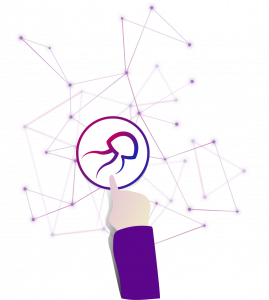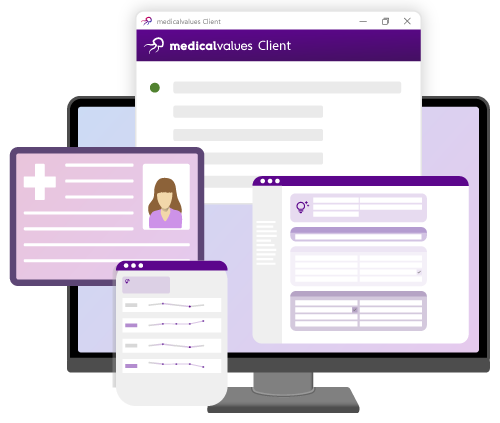medicalvalues Client -
Centrally organised and optimally integrated
Intelligent data distribution and integration for your clinic or practice with the medicalvalues client
SEAMLESSLY CONNECTED
The medicalvalues Client
The medicalvalues Client enables you to securely distribute medical data both internally and externally, facilitating the connection of various medical applications. It is compatible with all common AIS systems (e.g., tomedo, medatixx, inSuite, CGM Medistar, SMR, E-PAT, or Elexis). By connecting a wide range of source systems and printers, it can also orchestrate between different workstations.
EFFORTLESS MANAGEMENT AND INTEGRATION
Our dual Component Solution
The solution primarily consists of two components:
- Client Management: Online access for centralized configuration and management of various institution-wide settings.
Local Client: A locally installed application that enables data integration and structured data transfer into and out of the HIS, AIS, or LIS.

SOME OF THE ENDLESS POSSIBILITIES
Use Cases for the Client
Order Entry System
- A new order is created in the PMS.
- The client transmits the patient information for order creation to the Order Entry system.
- The order is assembled in the Order Entry system.
- The print job for the required labels and documents is sent to the printer via the client.
- The order information of the submitted order is sent to the PMS, and the report information is sent once available.
POCT
A POCT analysis is performed.
The result of the analysis is sent to the device workstation and processed.
The result is transmitted to the HIS (or LIS or PMS) via the clients.
Study Recruitment
- The client transmits patient information for eligibility screening from various source systems (e.g. PMS from different manufacturers).
- The study recruitment software matches the data.
- Matches are displayed as push notifications on the practice computer via the client.
Patient Portal
- A new patient is created in the PMS.
- Patient data is sent to the patient portal via the client.
- Automatic printing of a QR code and access information for the patient.
- The patient fills out a form (e.g., initial medical history) in the patient portal.
- The completed form data is sent back to the PMS.
BENEFITS
Benefit from modern and robust technology
Cross-platform availability
Support for various operating systems like Windows, Mac OS, and more
Highest stability
The Rust programming language ensures a modern and robust application
Data integration and interoperability
Decentralized FHIR APIs and targeted data sharing/importing, e.g., for DMP
KIM interface
Enables secure, standardized communication across healthcare systems
features
Flexibly adaptable, even for the most complex processes
Deep Integration
Controlled Data
Transfer
Data Distribution
Printer Management
Digital Signature
- Deep integration with modern AIS and HIS through data transfer via APIs & UI/UX plugins
- Individually triggered data transfer through controls in AIS or HIS, or setup of permanent data transfer managed and controlled in Client Management
- Internal and external data distribution (“data write-back,” e.g., DFÜ/LDT) to any APIs
- Advanced management and orchestration of printers
- Digital signature (Qualified Electronic Signature (QES), e.g., for prescription forms)
WELL CONNECTED
Make patient data usable for digital applications
Create medical and procedural statistics
Fail-safe and high performance thanks to continuous monitoring of the application status and automatic compensation
Practice Research
Create medical and procedural statistics

Order Entry System
Patient Portal
Order creation with automatic import of patient data
Provide your patients with processed, annotated reports and medication plans
Patient Forms
Data write-back into AIS
Get started and explore the possibilities

Recent News

From funding to practice with medicalvalues: Transforming clinics. Connecting care. Rethinking diagnostics.
Increasing complexity, a shortage of skilled workers, growing regulatory requirements and fragmented supply structures make it clear that selective digitization is no longer sufficient. Structural changes are needed.
With funding of up to €50 billion until 2035, the Hospital Transformation Fund (KHTF) opens up the possibility for the first time to implement concentration, specialization, telemedicine, and cross-sector care in a targeted and strategic manner.

Health In Your Hands: The Direct-To-Consumer Laboratory Model
The trend is clear: More and more people want to take their health into their own hands – digitally, directly, and effortlessly. As demand for consumer-oriented laboratory diagnostics grows, the role of traditional laboratories is changing. Instead of operating exclusively through physicians or clinics by offering traditional in-lab services, laboratories are increasingly addressing end consumers directly – online, via home test kits, or through walk-in locations.

